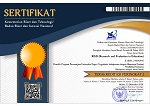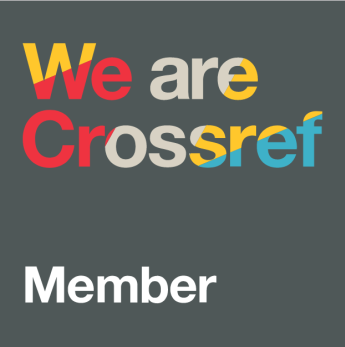A formative assessment model of critical thinking in mathematics learning in junior high school
DOI:
https://doi.org/10.21831/reid.v1i2.6472Keywords:
formative evaluation, critical thinking, mathematics learningAbstract
This study aims to obtain a valid and reliable formative evaluation model of critical thinking. The method used in this research was the research and development by integrating Borg & Gall's model and Plomp's development model. The ten steps Borg & Gall's model were modified into five stages as the stages in the Plomp's model. The subjects in this study were 1,446 students of junior high schools in DIY, 14 mathematics teacher, and six experts. The content validity employed was expert judgment, the empirical validity and reliability used were loading factor, item analysis used PCM 1PL, and the relationship between disposition and critical thinking skill used was structural equation modeling (SEM). The developed formative evaluation model is the procedural model. There are five aspects of critical thinking skill: mathematic reasoning, interpretation, analysis, evaluation, and inference, which entirely composed of 42 items. The validity of the critical thinking skill instruments achieves a significance degree as indicated by the lowest and the highest loading factors of 0.38 and 0.74 subsequently, the reliability of every aspect in a good category. The average level of difficulty is 0.00 with the standard deviation of 0.45 which is in a good category. The peer assessment questionnaire of critical thinking disposition consists of seven aspects: truth-seeking, open-minded, analysis, systematic, self-confidence, inquisitiveness, and maturity with 23 items. The critical thinking disposition validity achieves the significance degree as indicated by the lowest and the high factor loading of 0.66 and 0.76 subsequently, and the reliability of every aspect in a good category. Based on the analysis of the structural equation model, the model fits the data.References
Adams, R. J., & Khoo, S. (1996). Quest: The interactive test analysis system. Melbourne: Australian Council for Educational Research.
Basilevsky, A. (1983). Applied matrix algebra in the statistical sciences. Amsterdam: Elsevier Science Publishing
Ben-Zvi, D., & Garfield, J. (2005). The challenge of developing statistical literacy, reasoning and thinking. New York, NY: Kluwer Academic Publisher.
Bjorklund, D. F. (2005). Children's thinking. Belmort, CA: Wadsworth Thomson Learning.
Cheng, S., Liu E., Lin C., Teng, S., Tung, Y. (2008). Learning design on networked peer assessment for junior high. Proceeding of the 7th WSEAS International Conference on e-Activities. ISSN: 1790-5117.
Crowley, M. L. (1987). The van Hiele model of the development of geometric thought. In M. M. Lindquist and A. P. Shulte (eds.). Learning and teaching geometry, K-12,1987 Yearbook. Reston, VA: National Council of Teachers of Mathematics, 1–16.
Ennis, R. (1985). A logical basis for measuring critical thinking skills. Educational Leadership, 43(2), 44-48.
Ennis, R. (1993). Critical thinking assessment. Theory into Practice. 32(3), 179-186.
Ennis, R. (2011). Critical thinking: Reflection and perspective part I. Inquiry Critical Thinking Across the Discipline, 26(1), 4-18.
Ennis, R., & Weir, E. (1985). The Ennis-Weir critical thinking essay test. CA: Midwest Publications
Facione, P. A., Giancarlo, C. A., & Gainen, J. (1995). The disposition toward critical thinking. Journal of General Education, 44(1), 1-25.
Facione, P. A. (2000). The disposition toward critical thinking: Its character, measurement, and relationship to critical thinking. Informal Logic, 20(1), 61-84.
Facione, P. (1990). The California critical thinking skills test-college level. Technical report No. 3. Gender, ethnicity, major, CT self-esteem, and the CCTST. Milbrae.
Falchikov, N. (2005). Improving assessment through student involvement: Practical solutions for aiding learning in higher and further education. New York, NY: Routledge. ISBN-0-415-30821-6.
Ferdinand, A., 2002, Structure equation modeling dalam penelitian manajemen [Structure equation modeling in management research]. Semarang: Badan Penerbit Universitas Diponegoro.
Fischer, K. W. (1980). A theory of cognitive development: The control and construction of hierarchies of skills. Psychological Review, 87(6).
Gall, M., Gall, J. P., & Walter, B. R. (2003). Educational research: An introduction. (7th ed.). Boston: Allyn and Bacon.
Ghozali, I. & Fuad. (2008). Structural equation modeling, teori, konsep, dan aplikasi dengan program Lisrel 8,80 [Structural equation modeling theory, concept, and application with Lisrel 8.80 program]. Semarang: Badan Penerbit Universitas Dipenogoro.
Hair, J. F., Black, W., Babin, B.J., &Anderson R. E. (2010). Multivariate data analysis. (7th ed.). NJ: Pearson-Prentice Hall, Upper Saddle River.
Halpern, D. F. (2010). Halpen critical thinking assessment. Amsterdam: Schuhfried Gmbh.
Hambleton, R. K, & Swaminantha, H. (1985). Item response theory. Boston, MA: Kluwer Nijhoff Publishing.
Kawashima, N. & Shiomi, K. (2007). Factors of thinking disposition of Japanese high school students. Social Behavior and Personality, 35(2), 187-194.
Kartowagiran, B. (2008). Validasi dimensionalitas perangkat tes ujian akhir nasional SMP mata pelajaran Matematika 2003-2006. Jurnal Penelitian dan Evaluasi Pendidikan, 12(2), 177-195. Retrieved from http://journal.uny.ac.id/index.php/jpep/article/view/1426.
Kieran, C. (2004). Algebraic Thinking in the Early Grades: What is it?. The Mathematics Educator, 8(1), 139-151.
Kline, T. J. B., & Klammer, J. D. (2001). Path model analyzed with ordinary least square multiple regressions versus Lisrel. The Journal of Psychology, 135(2), 213-225.
Mardapi, D. (2008). Teknik penyusunan instrumen tes dan nontes [Technique of test and non-test instrument arrangement]. Yogyakarta: Mitra Cendikian
Mason, M. (2007). Critical thinking and learning. Educational Philosophy and Theory, pp. 339-349.
Nieto, A. M., & Saiz, C. (2011). Skills and disposition of critical thinking: Are they sufficient?. Analesde Psicologia, vol 27, pp. 202-209.
Plomp, T. (2007). Educational design research: An introduction. An introduction to educational design research. Proceedings of the seminar conducted at the East China Normal University, Shanghai (PR China), November 23-27.
Siegler, R. S., & Alibali M .W. (2005). Children thinking (4th ed.). New Jersey: Pearson Prentice Hall.
Siegel, H. (2010). Critical thinking. International Encyclopedia of Education, 6, 1441-1445. Auto's perconal copy. This article draws extensively upon Siegel 2003 and Bailin and Siegel 2003.
Schumacher, R. E., & Lomax, R. G. (1998). A beginner's guide to structural equation modeling (2rd ed.). New Jersey : Lawrence Erlbaum Associates.
Thompson, B. & Vacha-Haase, T. (2000). Psychometrics is datametrics: The test is not reliable. Ecucational and Psychological Measurement. 60, 174-195.
Van der Linden, W. J. & Hambleton, R. K. (1997). Handbook of Modern Item Res-ponse Theory. New York: Springer-Verlag New York, Inc
Van de Walle, J., Karp, K., Bay-William, J. (2011). Elementary and middle school mathematics: Teaching develops mentally. Boston, MA: Allyn & Bacon.
Wijanto, S. H. (2007). Structural equation modeling dengan Lisrel 8.8 [Structural equation modeling with Lisrel 8.8]. Jakarta: Graha Ilmu.
Downloads
Published
How to Cite
Issue
Section
License
The authors submitting a manuscript to this journal agree that, if accepted for publication, copyright publishing of the submission shall be assigned to REiD (Research and Evaluation in Education). However, even though the journal asks for a copyright transfer, the authors retain (or are granted back) significant scholarly rights.
The copyright transfer agreement form can be downloaded here: [REiD Copyright Transfer Agreement Form]
The copyright form should be signed originally and sent to the Editorial Office through email to reid.ppsuny@uny.ac.id

REiD (Research and Evaluation in Education) by http://journal.uny.ac.id/index.php/reid is licensed under a Creative Commons Attribution-ShareAlike 4.0 International License.






.png)





